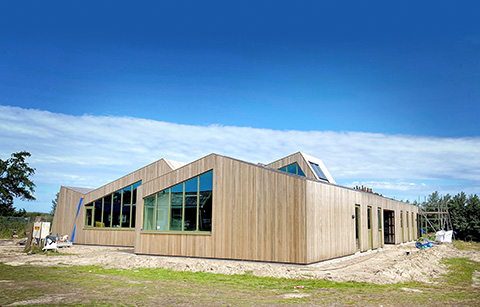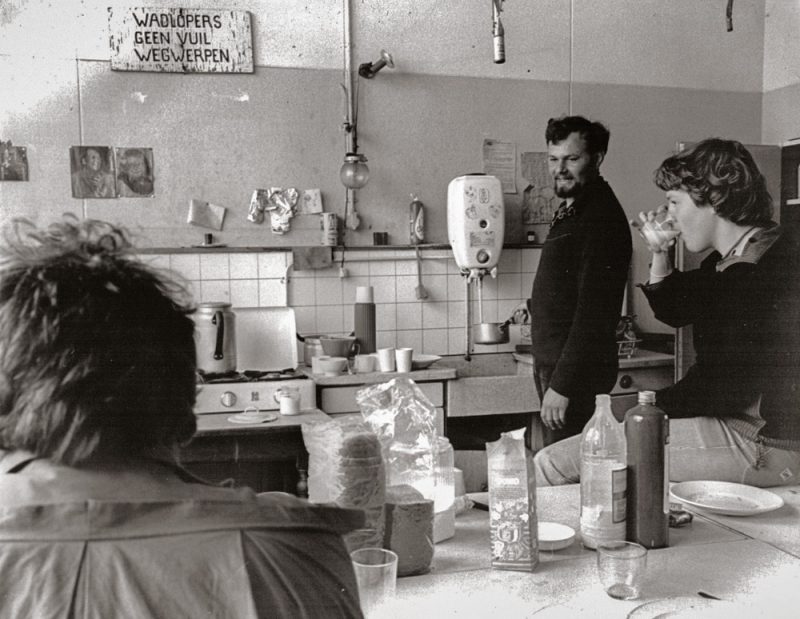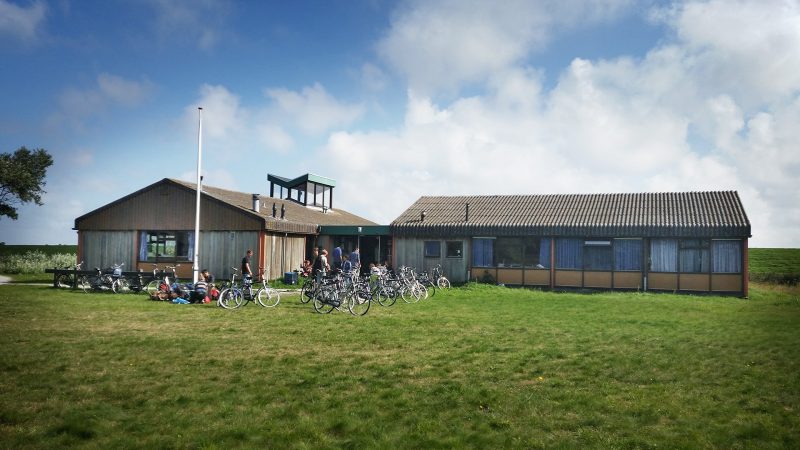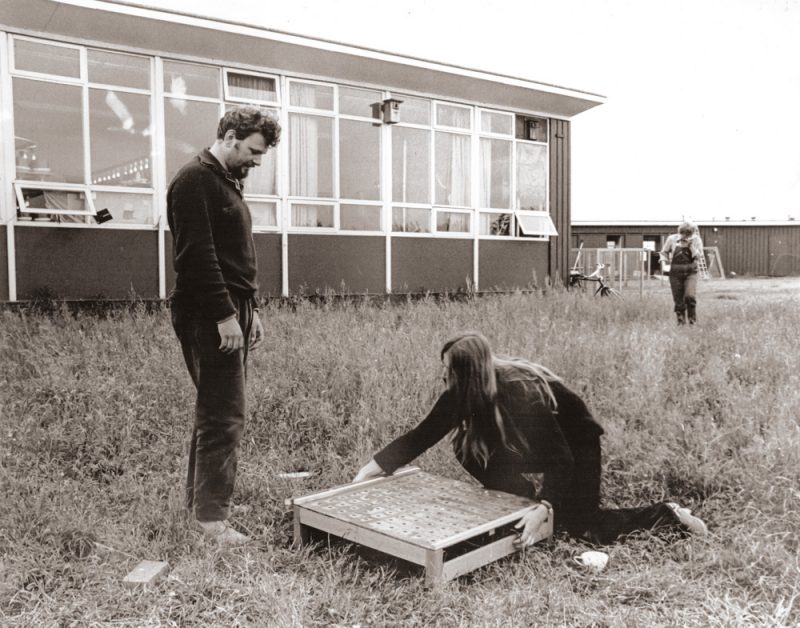
The place to fall in love
The Shepherd Hut
It’s the floating floor that left a lasting impression on people. Every time someone walked across the floor, the whole hut would shake, waking everybody up. And it’s not like people got a lot of sleep to begin with.
Ask any of the field biologist who ever stayed at the Shepherd’s Hut on Schiermonnikoog about it and they’ll tell you about how they formed friendships for life, saw the most amazing sunrises, and the countless goose droppings they kept track of. But mostly, they’ll tell you about how hard it was.
Goose droppings
They’ll tell you about sleeping thirty students to a room, with half of them coming home from a shift of collecting oysters at midnight, while the other half had to be up at three in the morning because they had to trek to the observation tower on the island’s eastern meadows. To study the aforementioned goose droppings.
‘It was intense’, says Nils Bunnefeld, who started out as a biology student in Groningen and is now working as a professor of biological and environmental sciences at the University of Stirling. ‘You couldn’t do it for too long, because of the continued lack of sleep and the long, labour-intensive days.’
If someone dropped a pencil on one side of the room, people would fall out of bed on the other side
‘If someone dropped a pencil on one side of the room, people would fall out of bed on the other side’, says retired ecology professor Joost Tinbergen, who regularly stayed in the Shepherd’s Hut in the seventies and later.
Prefab
‘The whole place was rickety’, retired ecology professor Jan Bakker recalls. ‘The first Shepherd’s Hut was completely dilapidated, but there wasn’t a lot of money for a new one. They went for a prefab building.’
However, the lack of sleep did nothing to dampen the fondness with which the Groningen biologist remember the biggest field station in the Netherlands. In fact, it’s almost the opposite. ‘It was a tough time, but we were going through it together’, says Tinbergen. ‘That’s what made it so much fun.’
‘We felt so privileged to be there’, says Bunnenfeld.
‘We were outside, and free as a bird’, says Bakker.

Rickety
All of them agree on one thing: how happy they were that the university maintained the field station. But the university hasn’t just maintained it: where once stood the prefab building that, in 1982, replaced the rickety first iteration of the hut that had been there since 1963 now stands a fully modernised, sustainable new hut.
‘It’s good that the university and the department stuck by their stance on ecology when commissioning the new building’, says ecology professor Han Olff. The new Shepherd’s Hut has solar panels, heat pumps, thirteen bedrooms with a total of thirty-nine beds, seventeen bathrooms, a common room, and a second storey that’s almost 6.5 metres high, providing a lookout point.
Necessary
It wasn’t a given that the station would be this great. Once, back in the seventies, nearly all universities and research organisations owned a field station. But there aren’t very many left. ‘Field stations are expensive’, says Tinbergen. ‘It’s an investment, like a cyclotron or a mass spectrometer, and necessary if you want to do ecological research in a natural environment. You can’t imagine how important it is to have a field station where students can learn the fundamentals of research.’
It’s been nearly sixty years since the university acquired the Shepherd’s Hut. Legendary ethologist Gerard Baerends, the man who painted fake seagull eggs in the strangest patterns and who made square and glass eggs to figure out what birds do to recognise their eggs, had been a professor in Groningen since 1946. He was greatly in favour of field work. ‘Until then, he’d done most of his work on the island of Terschelling’, says Bakker.
In 1985, a golden opportunity presented itself. For years, Groningen farmers had been taking their cows to Schiermonnikoog during the summer to graze. A cowherd who lived in a small hut on the east marshes would look after them. ‘But there’s a type of snail that lives in the marches that can cause liver fluke if cows eat it’, says Bakker. ‘All the cows came back sick.’

Empty
The island was under government control. With the hut empty, the domain’s supervisor made a deal with Baerends: the university was allowed to use it.
Back then, there was just a small hut’, says Nel Drent, widow Baerend’s successor, who died in 2008. ‘All it had was a little kitchen, a small living room, and a small bedroom with two bunk beds.’
‘There was no electricity, and no gas’, says Drent. ‘We had to stay warm using oil burners, but we couldn’t use those all the time, because they suck the oxygen from the air.’ Not that this was an issue: ‘We were outside anyway’, she says. ‘Besides, we didn’t need much. Aren’t tiny houses all the rage these days? That’s what this was!’
The walls were unbelievably thin. And the building was bloody hot!
During the first few years of the Shepherd’s Hut, only Baerends used the small sanctum; any students he brought along slept outside in tents. It wasn’t until 1963 that a temporary building that was no longer needed was moved from the Kraneweg in Groningen to the island and named the ‘Big Shepherd’s Hut. The original small Shepherd’s Hut exists to this day.
Bloody hot
Doctoral and PhD students finally had a roof over their heads, while ‘normal’ students were still relegated to tents. ‘It was indeed a roof’, says Tinbergen. ‘But the walls were so unbelievably thin. And it was bloody hot inside the building!’

Starting in 1972, Rudi and Nel Drent lived there during the six-week courses that were taught at the hut. ‘Our kids would go to school on the island, where they were taught by master Koning’, says Nel Drent. ‘It was the eighties, so it was all fine.’ Until the oldest one went to high school.’
During the early years, Nel helped her husband with his PhD research into the way seagulls turned their eggs in the nest. ‘Nel and Rudi had built this thing that looked like a coffin with a glass plate on top, and put it under a seagull nest’, says Bakker. ‘Rudi would lie down in it to study what happened underneath the seagull.’
On other days, Drent would take students from the newly popular ecology courses up to the observation hut. They would stay there for hours. He’d also take them through any provisional data and drew them quick graphs.
All together
Maarten Loonen, who regularly visited the field station starting in 1982, says this might be the most important aspect of the Shepherd’s Hut: students, scientists, and top researchers all worked, slept, and ate in the same location. ‘I sometimes wonder how much I learned from going to class and how much I learned from watching and copying other people.’
Sometimes a professor would join and you’d spend four hours together
For Loonen, the hut was the first place he ever studied geese, and the animals have remained the topic of his research for the rest of his career. It’s also where he laid the basis for his large network. Over the years, ecologists spent hours together in observation huts, trudging through the marshes in heavy rain gear, lying awake in the dormitory, building hides in the Willems dunes, and smearing the dirt from their boots all over the inside of the Shepherd’s Hut. Now, decades later, they’ve kept in touch, working together and publishing articles together. ‘It was great for team building’, says Loonen.
‘We’d be outside on the fields from sunup to sundown’, says Olff. His career was also formed on Schiermonnikoog. ‘Sometimes a professor would join us because they were going the same way. You’d easily spend four hours together.’
Passion
It’s where the passion for the field was passed on from Baerends to Drent, from Drent to Bakker and Tinbergen, and from them to Han Olff, Chris Smit, Maarten Loonen, and countless others.
The university profited, too. ‘The hut attracted world-class scientists over the years’, says Bunnefeld. He means Baerends and Drent, but also everyone who succeeded them: Joost Tinbergen and Jan Bakker, Theunis Piersma, Han Olff, and many others. ‘It’s impressive that the university was at the top for so long.’
So far, the Shepherds Hut has been good for ‘seventy dissertations’, Bakker calculates. ‘Four hundred scientific articles, 160 Dutch reports.’ And last, but not least: ‘Thirty articles in Schiermonnikoog’s local paper De Dorpsbode.’